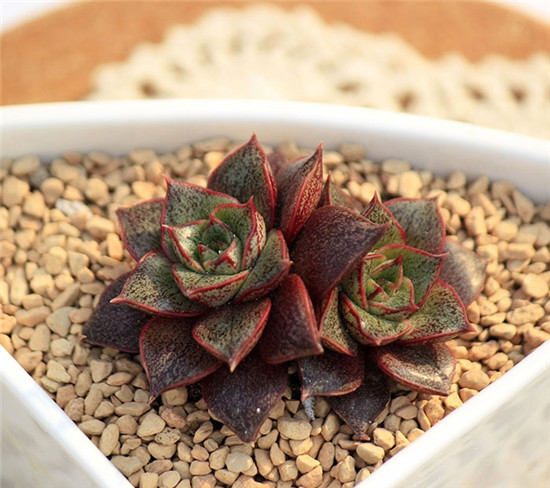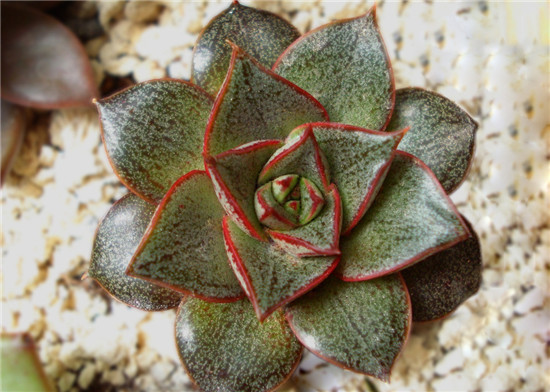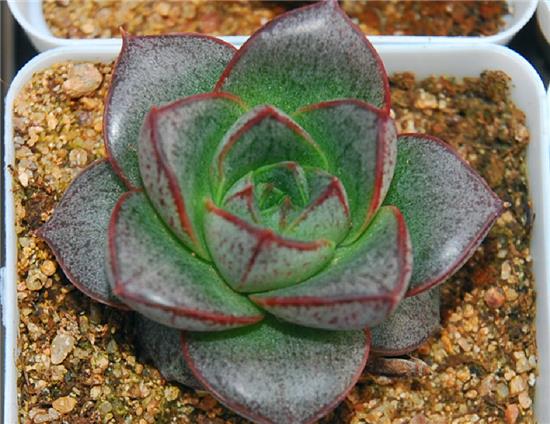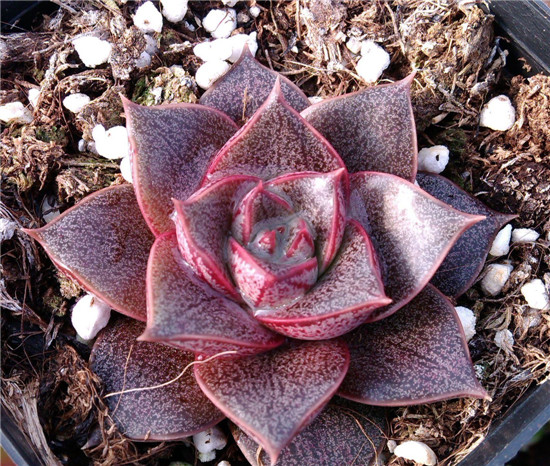[Dahejin] introduction and culture methods of Dahejin
Dahejin is a succulent plant of the genus Euphorbiaceae, with succulent leaves arranged in a tight rosette. Next, let's take a look at the introduction and breeding methods of Daiwa brocade.

Morphological characteristics of Dahejin
The leaves of Dahejin are broadly ovate to scattered triangular-ovate, with keel-shaped protuberances on the back. The leaves are 3 to 4 meters long and 3 meters wide, and the apex is acute. The leaves are grayish green with reddish-brown markings. Using leaf cuttings, you can see the whole process of a leaf budding and growing into a plant, which is very interesting.
Triangular leaves like keels with beautiful reddish-brown markings. Under sunny conditions, the leaves are compact and thick. The red pattern is also more obvious.
Dahejin is a succulent plant of crassulaceae, with triangular thick leaves stacked like petals, dark green leaves with purple-brown spots, and another variety called "Daheji", which is more beautiful.
Ecological habits of Dahejin
Dahe Jinxi has a warm and well-ventilated environment with no obvious dormancy period. Fertile and well drained sandy soil should be used for cultivation. The growing period requires a certain amount of air humidity, controlled watering in winter, and can withstand 5 ℃ of low temperature.

The breeding process of Dahejin
The reproduction of Dahejin is generally beheaded, the cubs are cut and the leaves are cut. The cut plants can be directly planted in the dry granular soil, and a small amount of water can be supplied after rooting. Is a very good breed, leaf insertion is to take complete and full leaves, put in a cool place to dry the wound, and then placed on the slightly wet soil, it will slowly grow roots and sprout, the process is a bit long, but you can get a lot of small lateral buds, lateral buds grow, take off the plug can be inserted.
The leaves should be taken from Daiwa brocade. The leaves are broken off and hung for 1 to 2 days, placed horizontally or obliquely in coarse sand or vermiculite, so that the wound touches the soil and is placed in the semi-shade to keep the soil slightly moist. Buds grow in the wound after 15 to 20 days. With the passage of time, the buds grow bigger and bigger, and gradually form small rosette-like foliage. When the plant grows to a certain size, it is taken out and planted in a small pot, that is, it becomes a new plant.

Main points of cultivation:
Dahejin needs plenty of sunshine and cool, dry environment, resistant to semi-overcast, afraid of waterlogging, avoid muggy and humid. It has the habit of growing in cool season and dormant at high temperature in summer. The period from September to June of the second year is the growing period of the plant (the environment of the flower friend is different, and the growing period is also short). If the light is not enough, the leaves will grow too long, and the red edge of the leaves will slowly fade; while the plants that grow in sunny places will be short and strong, and the leaves will be arranged compactly.
Soil can be mixed with cinder peat, a small amount of perlite, the proportion is about 5:4:1.

Winter and summer conservation:
Daiwa Jinneng can withstand a low temperature of about minus 4 ℃, which is the indoor temperature. If it is not in the open air, the top growing point of the lower leaves will appear frostbite, dry up and die, and the water will be cut off basically throughout the winter, and the water will begin to be cut off slowly below 5 degrees. When the summer high temperature, the whole plant growth is slow or completely stopped, at this time to be well ventilated and properly shaded, avoid exposure, control watering, not long-term rain, so as to avoid plant rot.
The above is all the contents of the introduction and breeding methods of Daiwa brocade that I have summarized for you. I hope this article can help you. Please continue to follow us.
Related
- Wuhan Hospital Iron Tree Blooming Result Was Instantly Frightened by the Gardener Master
- Which variety of camellia is the most fragrant and best? Which one do you like best?
- What is the small blue coat, the breeding methods and matters needing attention of the succulent plant
- Dormancy time and maintenance management of succulent plants during dormancy
- Minas succulent how to raise, Minas succulent plant pictures
- What are the varieties of winter succulent plants
- How to raise succulent plants in twelve rolls? let's take a look at some experience of breeding twelve rolls.
- Attention should be paid to water control for succulent plants during dormant period (winter and summer)
- Watering experience of twelve rolls of succulent plants
- Techniques for fertilizing succulent plants. An article will let you know how to fertilize succulent plants.



